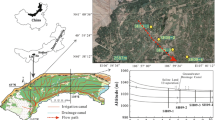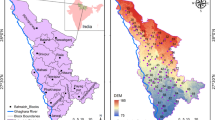Abstract
Dissolved arsenic mobility in the environment is controlled by its associations with solid-phase As and other minerals by chemodynamics of adsorptions and co-precipitation. Arsenic mobilization potential and mechanisms in the groundwater of a part of the river Brahmaputra alluvial plain in India were inferred from aqueous and solid-phase geochemical analyses of groundwater samples and sediment cores from various depths. Sediments were analyzed for key parameters, e.g., total and sequentially extracted Fe, As, and Mn; organic carbon content; carbonate phases; and specific surface area, while groundwater samples collected from close proximity of the drilled bore well were analyzed for major and trace element hydrogeochemistry. Result shows Mn- and Fe-oxyhydroxides as the major leachable As solid phases. Median total leachable solid-phase As was found to be ~9.50 mg/kg, while groundwater As ranged between 0.05 and 0.44 mg/L from adjoining water wells. Morphological and mineralogical studies of the aquifer sediments conducted using scanning electronic microscope energy-dispersive X-ray (SEM-EDX) and X-ray diffraction (XRD) analysis indicate the major presence of Fe- and Mn-oxyhydroxides. Sequential leaching experiments along with the mineralogical studies suggest that bacterially mediated, reductive dissolution of MnOOH and FeOOH is probably an important mechanism for releasing As into the groundwater from the sediments.






Similar content being viewed by others
References
Acharyya, S. K. (2002). Arsenic contamination in ground water affecting major parts of southern West Bengal and part of western Chattisgarh: source and mobilization process. Current Science, 82, 740–744.
Ahmed, K. M., Bhattacharya, P., Hasan, M. A., Akhter, S. H., Alam, S. M. M., & Bhuyian, M. A. (2004). Arsenic enrichment in groundwater of the alluvial aquifers in Bangladesh: an overview. Applied Geochemistry, 19, 181–200.
Bengston, L., & Enell, H. (1986). Chemical analysis. In B. E. Buglund (Ed.), Handbook of Holocene paleoecology and paleohydrology (pp. 23–51). Chichster: John Wiley.
Breit, G. N., Lowers, H. A., Foster, A. L., Bern, A. M., Yount, J. C., Whitney, J., Clark, D. W., Uddin, M. N., & Muneem, A. A. (2004). Changes in the binding of arsenic to sediment in southern Bangladesh – a record of microbially facilitated transformations. GSA Annual Meeting Abstract, 36(5), 398.
Bhattacharya, P., Chatterjee, D., & Jacks, G. (1997). Occurrences of arsenic contaminated groundwater in alluvial aquifer from delta plains eastern India: option for safe drinking water supply. Journal of Water Resource Development, 13, 79–92.
Bhattacharya, P., Jacks, G., Jana, J., Sracek, P., Gustafsson, J.P., & Chatterjee, D. (2001). Geochemistry of the Holocene alluvial sediments of Bengal Delta plains from West Bengal, India: implications on arsenic contamination in groundwater. In, Groundwater arsenic contamination in the Bengal Delta plain of Bangladesh, KTH special publication. TRITAAMI Report, 21-40.
Blute, N. K., Jay, J. A., Swartz, C. H., Brabander, D. J., & Hemond, H. F. (2009). Aqueous and solid phase arsenic speciation in the sediments of a contaminated wetland and riverbed. Applied Geochemistry, 24, 346–358.
Borah, K., Bhuyan, B., & Sarma, H. P. (2009). Lead, arsenic, fluoride, and iron contamination of drinking water in the tea garden belt of Darrang district, Assam, India. Environmental Monitoring and Assessment, 169, 347–352.
Chetia, M., Chatterjee, S., Banerjee, S., Nath, M. J., Singh, D., Srivastava, R. B., & Sarma, H. P. (2010). Groundwater arsenic contamination in Brahmaputra river basin: a water quality assessment in Golaghat (Assam), India. Environmental Monitoring and Assessment, 173, 1393–1398.
CGWB, (2008). Central Ground Water Board, Ministry of water resources Government of India, Information Booklet. Jorhat District. http://cgwb.gov.in/
Cullen, W. R., & Reimer, K. J. (1989). Arsenic speciation in the environment. Chemical Review, 89, 713–764.
Chakraborti, D., Sengupta, M. K., Rahman, M. M., Ahamed, S., Chowdhury, U. K., Hossain, M. A., Mukherjee, S. C., Pati, S., et al. (2004). Groundwater arsenic contamination and its health effects in the Ganga–Meghna–Brahmaputra plain. Journal of Environmental Monitoring and Assessment, 2004, 74–83.
Dean, W.E. Jr. (1997). Determination of carbonate and organic matter in calcareous sediments and sedimentary rocks by loss on ignition: comparison with other methods. Journal of Sedimentary Petrology, 22–28.
Dixit, S., & Hering, J. G. (2003). Comparison of arsenic (V) and arsenic (III) sorption to iron oxide minerals: implications for arsenic mobility. Environmental Science and Technology, 37, 4182–4189.
Eliche, E. (2009). Arsenic mobilization is red river delta, Vietnam - towards, better understanding of the patchy distribution of dissolved arsenic in alluvial deposits. PhD thesis, Scientific publishing.
Frentiu, T., Ponta, M., Levei, E., Gheorghiu, E., Kasler, I., & Cordos, E. A. (2008). Validation of the Tessier scheme for speciation of metals in soil using the Bland and Altman test. Chemical Papers, 62(1), 114–122.
Goldberg, S., & Johnston, C. (2001). Mechanisms of arsenic adsorption on amorphous oxides evaluated using macroscopic measurements, vibrational spectroscopy, and surface complexation modeling. Journal of Colloid Interface Science, 234, 204–216.
Goswami, R., Rahman, M. M., Murrill, M., Sarma, K. P., Thakur, R., & Chakraborti, D. (2013). Arsenic in the groundwater of Majuli - the largest river island of the Brahmaputra: magnitude of occurrence and human exposure. Journal of Hydrology. doi:10.1016/j.jhydrol.2013.09.022.
Haavard, H. (2004). Trace elements determination AAS. Norwegian Institute for Water Research. Horizontal - 20.
Haque, S., Ji, J., & Johannesson, K. H. (2008). Evaluating mobilization and transport of arsenic in sediments and groundwaters of Aquia aquifer, Maryland, USA. Journal of Hydrology, 99, 68–84.
Hasan, M. A., Ahmed, K. M., Sracek, O., Bhattacharya, P., von Brömssen, M., Broms, S., Fogelstrom, J., Mazumder, M. L., & Jacks, G. (2007). Arsenic in shallow groundwater of Bangladesh: investigations from three different physiographic settings. Hydrogeology Journal, 15, 1507–1522.
Horneman, A., van Green, A., Kent, D. V., Mathe, P. E., Zheng, Y., Dhar, R. K., et al. (2004). Decoupling of As and Fe release to Bangladesh groundwater under reducing conditions. Part I: evidence from sediment profile. Geochemica et Cosmochimica Acta, 68, 3459–3475.
Manning, B. A., & Goldberg, S. (1996). Modeling arsenate competitive adsorption on kaolinite, montmorillonite, and illite. Clays Clay Mineralogy, 44, 609–623.
Manning, B. A., & Goldberg, S. (1997). Adsorption and stability of arsenic (III) at the clay mineral–water interface. Environmental Science and Technology, 31, 2005–5011.
Mahanta, C., Choudhury, R., Dutta, A., Basu, S., Borah, P., Saikia, L., Alam, W., and Dutta, R. (2010). Groundwater arsenic contamination in the Brahmaputra floodplain, Assam, India- a comprehensive field investigation. Proceedings of the EWRI conference, 3rd international perspectives on current and future state of the water resources and the environment, at IIT Madras.
Martínez-Fernández, M., Barciela-Alonso, M. C., Moreda-Piñeiro, A., & Bermejo-Barrera, P. (2011). Matrix solid phase dispersion-assisted BCR sequential extraction method for metal partitioning in surface estuarine sediments. Talanta, 83(3), 840–849.
Moeck, P. (2008). Structural identification of cubic iron-oxide nanocrystal mixtures: X-ray powder diffraction versus quasi-kinematic transmission electron microscopy. Supplemental Proceedings of TMS, 137th Annual Meeting & Exhibition, Volume 1, Materials Processing and Properties, 25-32.
Mukherjee, A., Scanlon, B. R., Fryar, A. E., Dipankar, S., Ghosh, A., Chowdhuri, S., et al. (2012). Solute chemistry and arsenic fate in aquifers between the Himalayan foothills and Indian craton (including central Gangetic plain): influence of geology and geomorphology. Geochemica et Cosmochimica Acta, 90, 283–302.
Nickson, R., McArthur, J., Burgess, W., Ahmed, K. M., Ravenscroft, P., & Rahman, M. (1998). Arsenic poisoning of Bangladesh groundwater. Nature, 395, 338.
Nickson, R. T., McArthur, J. M., Ravenscroft, P., Burgress, W. G., & Ahmed, K. M. (2000). Mechanism of arsenic release to groundwater, Bangladesh and West Bengal. Applied Geochemistry, 15, 403–413.
Pierce, M. L., & Moore, C. B. (1982). Adsorption of arsenite and arsenate on amorphous iron hydroxide. Water Research, 16, 843–846.
Reza, H. A. M. S., Jean, J. S., Lee, M. K., Liu, C. C., Bundschuh, J., Yang, H. J., et al. (2010). Implications of organic matter on arsenic mobilization into groundwater: evidence from northwestern (Chapai-Nawabganj), central (Manikganj) and eastern (Chandpur) Bangladesh. Water Research, 44, 5556–5574.
Sharma, J. N. (2005). Fluvial process and morphology of the Brahmaputra River in Assam, India. Geomorphology, 70, 226–256.
Singh, A. K., Hasnain, S. I., & Banerjee, D. K. (1999). Grain size and geochemical partitioning of heavy metals in sediments of Damodar River- a tributary of the Ganga, India. Environmental Geology, 39, 90–98.
Singh, A.K. (2004). Arsenic contamination in groundwater of North Eastern India. In Proceedings of 11th national symposium on hydrology with focal theme on water quality. National Institute of Hydrology, Roorkee, 255-262.
Smedley, P. L., & Kinniburgh, D. G. (2002). A review of the source, behaviour and distribution of arsenic in natural waters. Applied Geochemistry, 17, 517–568.
Smith, A. H., Hopenhayn-Rich, C., Bates, M. N., Goeden, H. M., Hertz-Picciotto, I., & Duggan, H. M. (1992). Cancer risks from arsenic in drinking water. Environmental Health Perspectives, 97, 259–267.
Smith, A. H., Arroyo, A. P., Mazumder, D. N., Kosnett, M. J., Hernandez, A. L., & Beeris, M. (2000). Arsenic-induced skin lesions among Atacameno people in Northern Chile despite good nutrition and centuries of exposure. Environmental Health Perspective, 108, 617–620.
Smith, A. H., Ercumen, A., Yuan, Y., & Steinmaus, C. M. (2009). Increased lung cancer risks are similar whether arsenic is ingested or inhaled. Journal of Exposure Science Environmental Epidemiology, 19(4), 343–348.
Sompongchaiyakul, P., & Sirinawin, W. (2007). Arsenic, chromium and mercury in surface sediment of Songkhla Lake system, Thailand. Asian Journal of Water, Environment and Pollution, 4, 17–24.
Tessier, A., Campbell, P. G. C., & Bisson, M. (1979). Sequential extraction procedure for the speciation of particulate trace metals. Analytical Chemistry, 51, 844–885.
Tuutijärvi, T., Repo, E., Vahala, R., Sillanpää, M., & Chen, G. (2012). Effect of competing anions on arsenate adsorption onto maghemite nanoparticles. Chinese Journal of Chemical Engineering, 20(3), 505–514.
Tye, A. M., Young, D., Crout, N. M., Zhang, H., Preston, S., Bailey, E. H., Davison, W., McGrath, S. P., Paton, G. I., & Kilham, K. (2002). Predicting arsenic solubility in contaminated soils using isotopic dilution techniques. Environmental Science and Technology, 36, 982–988.
Waltham, C. A., & Eick, M. J. (2002). Kinetics of arsenic adsorption on goethite in the presence of sorbed silicic acid. Soil Science Society of America Journal, 66, 818–825.
Waychunas, G. A., Rea, B. A., Fuller, C. C., & Davis, J. A. (1993). Surface chemistry of ferrihydrite. Part 1. EXAFS Studies of the geometry of coprecipitated and adsorbed arsenate. Geochimica et Cosmochimica Acta, 57, 2251–2269.
Welch, A. H., & Stollenwerk, K. G. (2003). In situ arsenic remediation in a fractured, alkaline aquifer. In A. H. Welch & K. G. Stollenwerk (Eds.), Arsenic in ground water: geochemistry and occurrence (pp. 403–420). Boston: Kluwer Academic Publishers.
Acknowledgments
The authors would like to thank Ms. Jonali Saikia and Dr. Sandip Mondal for providing laboratorial assistance. The authors would also like to thank the Indian Institute of Technology Guwahati for organizing funds for this research.
Author information
Authors and Affiliations
Corresponding author
Rights and permissions
About this article
Cite this article
Baviskar, S., Choudhury, R. & Mahanta, C. Dissolved and solid-phase arsenic fate in an arsenic-enriched aquifer in the river Brahmaputra alluvial plain. Environ Monit Assess 187, 93 (2015). https://doi.org/10.1007/s10661-015-4277-0
Received:
Accepted:
Published:
DOI: https://doi.org/10.1007/s10661-015-4277-0




